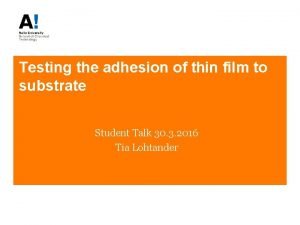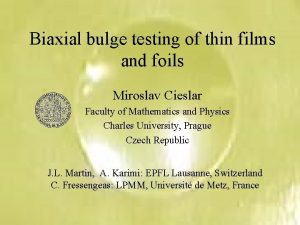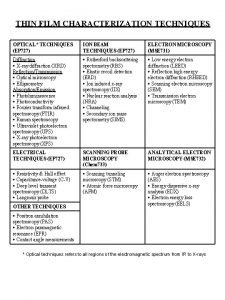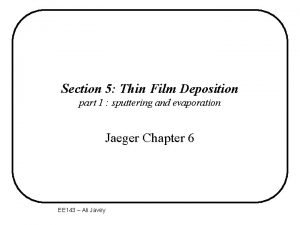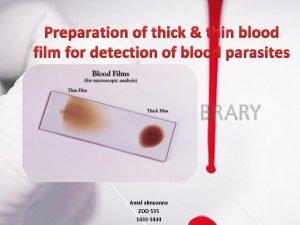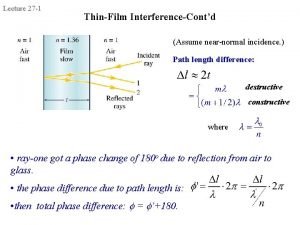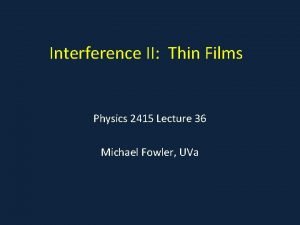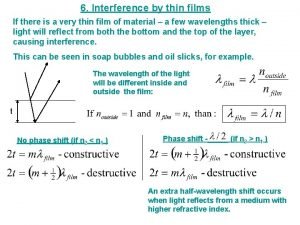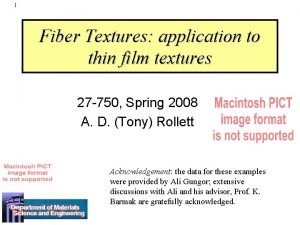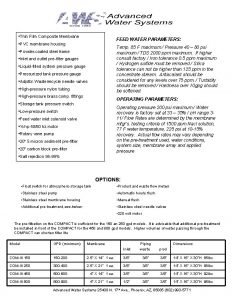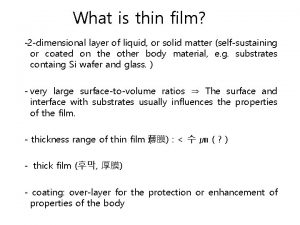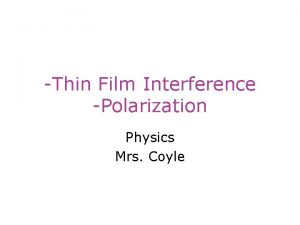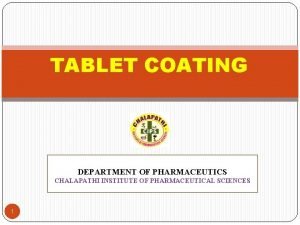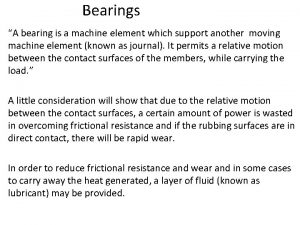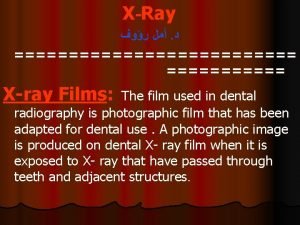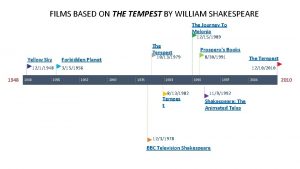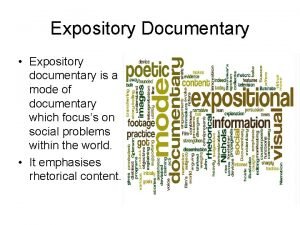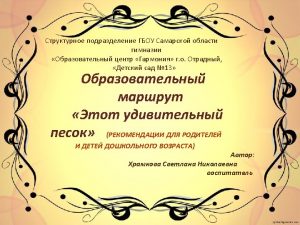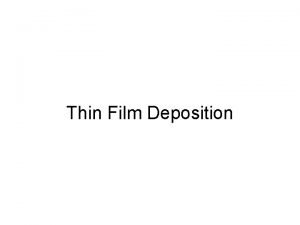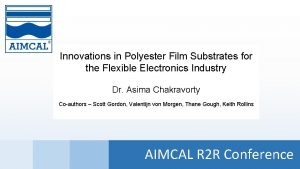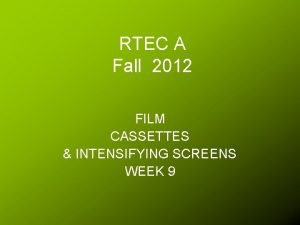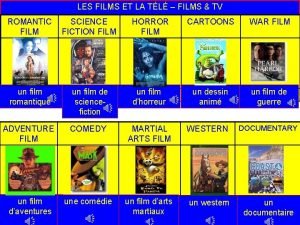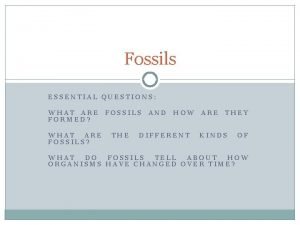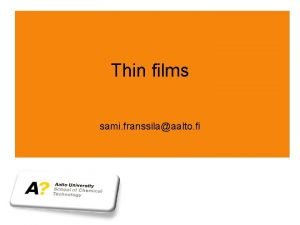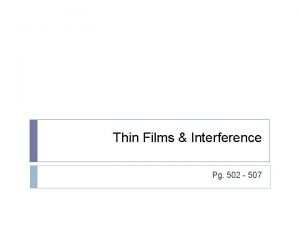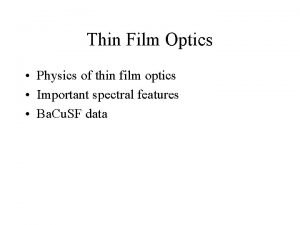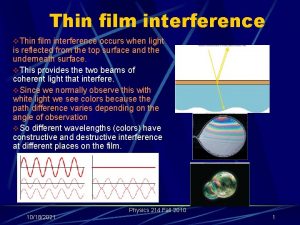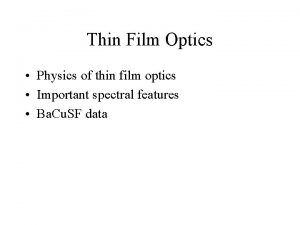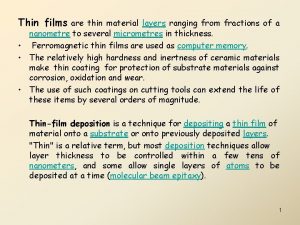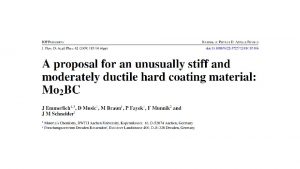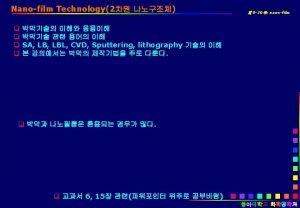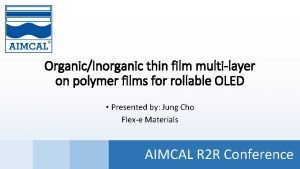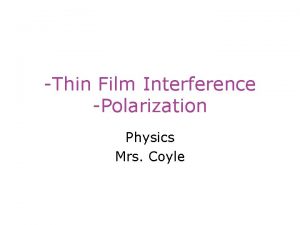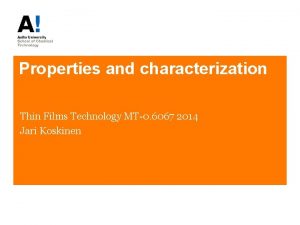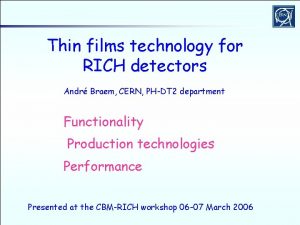Purpose of the Thin Film Technology Thin Films






































































- Slides: 70



Purpose of the Thin Film Technology ØThin Films are deposited onto bulk material (Sub. ) to achieve properties unattainable or not easily attainable in the substrate alone. ØWhat properties are required for the application at hand? 3

Thin-Film Applications 4

薄膜成長基本步驟 1. 原子/分子的吸收(物理性吸收) 2. 表面擴散 (Surface Diffusion) Need energy 3. 分子-分子及基板-分子鍵結形成(化學性吸附) 4. 成核(Nucleation): aggregation of single atoms/molecules 5. 結構及微結構形成(amorphous, polycrystalline, single crystal, defects, roughness, etc…) 6. 膜本體內部之改變(diffusion, grain growth, etc. ) 5

How to Obtain the Thin Films • Poly-Si deposition • Epi-Si deposition • Dielectrics (Si. O 2 , Si 3 N 4 , Ti 2 O 5 ) deposition • Metals (Al-Cu, Ti. N, W, Cu, Ta. N) deposition Chemical vapor deposition (CVD) A(g)+B(g) →C(s) ↓+D(g) Physical vapor deposition (PVD) A(s) →A(g) →A(s) 6


Metallization Structure Semiconductor industry uses PVD to deposit the metal that electrically connects the various parts of the IC to each other and to the outside world. There are four common structures in metallization: contacts, vias, plugs and interconnects. Via 2 Interconnects Metal 3 Silicon Dioxide (ILD) Metal 2 Via 1 Silicon Dioxide (ILD) Metal 1 Silicon Dioxide Contact Silicon 8










直流式之電漿原理 *當帶有能量之ions撞擊surface of material, 將發生以下四種cases. (1) E<10 e. V, ion可能被material表面吸附, 而以熱方式釋放能量. (2) E>10 Ke. V ion penetrates into the material many atomic large spacing, most of its energy deep into the substrate, where it changes the physical structure. (ion implantation). (3)若能量介於 10 e. V <E< 10 Ke. V, 則將有兩種energy transfer mechanisms 發生. (a) Part of the ion energy is deposited in the form of heat. (b) Remainder goes into a physical rearrangement of the substrate. ions將與target表面很多層原子互相作用. target atoms and clusters of atoms 將被ejected from the surface of the target. (with 10 to 50 e. V; 此些大約有evaporated atoms之100倍以上的能量). 提供 sputtered atoms具有額外之surface mobility, 以致能停留在substarte表面 最低 能量位置. 被sputtering出來約95%為atomic, 其餘可能為diatomic molecules. 18




DC Sputter deposition -V (DC) (glow discharge) Cathode shield Schematic diagram of DC powered sputter deposition equipment Vacuum ground 22

DC Sputter system Plasma structure and voltage distribution Bulk of plasma contains equal con. of ions & electrons. Al, W, Ti, silicides, other metals Electric potential ~constant Voltage drop ~across the sheath regions. Plasma used in processing is a “weak” plasma, containing mostly neutral atoms/molecules (10 -3 to 10 -6) 23

Processes in sputter deposition Al e- 只適用於導電材料 Power Supply 24

Sputtering yield in a DC system 25

Sputtering yield in a DC system Defined as the number of atoms ejected per incident ion. Typically, range 0. 1 -3. Determines the deposition rate. Depends on: Target material. Mass of bombarding ions. Energy of the bombarding ions. Direction of incidence of ions (angle). 26

Contact hole filling problem Fort aspect ratios A = w/d smaller than approximately 1, the layer at the edge of the contact hole will become unacceptably thin or will even be non-existing - the contact to the underlying structure is not established. 27

Contact hole filling problem –– the real thing Real thing together with one way to overcome the problem is shown above (the example is from the 4 Mbit DRAM generation, around 1988). 28

RF sputter deposition Real thing together with one way to overcome the problem is shown above (the example is from the 4 Mbit DRAM generation, around 1988). 29

Reactive sputter deposition Real thing together with one way to overcome the problem is shown above (the example is from the 4 Mbit DRAM generation, around 1988). 30

Magnetron sputter deposition 31

PVD -- (Sputtering deposition) 32





薄膜成長機制 Substrate 37





Sputtering Yield of Ar 42

Sputtering Yield of Ar 43

44

45

46

A 1 47

48

49

50

Bias sputtering • Sometimes bias sputtering of the wafer is desirable. This is done by reversing the electrical connections. • One application would be for precleaning the wafer before the actual deposition. • During this step, a controlled thickness of surface material is sputtered off the wafer, removing any contaminants or native oxide. • A film can then be sputter deposited immediately afterward without breaking the vacuum. 51

Bias sputtering • Useful for cleaning contact/vias. • Sputter etching has serious problems as particles. 52

Thermal Dissipation is not good. 53

54

55

56

57

58

59

D e p o s i t i o n R a t Data From ITRI 60

Reaction Process Models of Ir. O 2 Films by Reactive Sputtering 61

Reaction Process Models of Ir. O 2 Films by Reactive Sputtering 62

Substrate Temp. effect on the Ir. O 2 Resitivity 63

X R D p a t t e r n s o f I r 64

Manufacturing methods Thin film Equipment Al Magnetron sputter Ti and Ti. W Magnetron Ti. N Reactive sputtering Cu Typical reaction Comments 25 -300 C – standard 440 -550 C – hot Al Ti + N 2 (in plasma) Electroplating ÞTi. N Cu 2+ + 2 e- ÞCu 65

I T O S p u t t e r i n g ( i Applications of Sputtering 66

In-Line ITO Design Vertical substrate orientation ( 85°) : low particle contamination Cathode design : high deposition rate, low resistivity ITO and metal Heater design : homogeneous substrate temperature distribution Flexibility : ITO and others (Si. O 2 , Cr, Mo, Ti, Ta, . . ) using the same architecture 67

• 4 t h G e n e r a t i o n : M 4 th ITO Sputtering System 68

Sputtering for Components 69

 Working titles films
Working titles films Thin films testing
Thin films testing Bulge test thin films
Bulge test thin films Thin film characterization techniques
Thin film characterization techniques Sputtering thin film
Sputtering thin film Thick and thin film preparation
Thick and thin film preparation Interference in thin film
Interference in thin film What is thin film in physics
What is thin film in physics Interference in thin film
Interference in thin film Thin film texture
Thin film texture Resolving power equation
Resolving power equation Pvc membrane film
Pvc membrane film Small scale integrated circuit
Small scale integrated circuit What is thin film
What is thin film Film interference
Film interference Opaquant extender meaning
Opaquant extender meaning Thin film interference
Thin film interference Wedge film journal bearing
Wedge film journal bearing The tube side of the dental film packet
The tube side of the dental film packet How to analyze films
How to analyze films Journey to melonia
Journey to melonia Readymade films
Readymade films Hollywood renaissance films
Hollywood renaissance films Typical codes and conventions of short films
Typical codes and conventions of short films Delia crawford
Delia crawford Characteristics of documentary films
Characteristics of documentary films What is a expository documentary
What is a expository documentary Ftd newsgroup
Ftd newsgroup Interactive movie maker
Interactive movie maker What is single camera production
What is single camera production No wave film
No wave film Yandex film ru
Yandex film ru Yandex film b****
Yandex film b**** I like to watch movies in my free time
I like to watch movies in my free time Alternative films
Alternative films Melinex st
Melinex st Claus tieber
Claus tieber Opkoper dvd films
Opkoper dvd films St trinians films
St trinians films Radiographic films
Radiographic films Tlfilms
Tlfilms Describing films
Describing films Questions about fossils
Questions about fossils In his course steven roberts uses original films with
In his course steven roberts uses original films with Team plus hr services pvt ltd
Team plus hr services pvt ltd Hát kết hợp bộ gõ cơ thể
Hát kết hợp bộ gõ cơ thể Bổ thể
Bổ thể Tỉ lệ cơ thể trẻ em
Tỉ lệ cơ thể trẻ em Gấu đi như thế nào
Gấu đi như thế nào Glasgow thang điểm
Glasgow thang điểm Hát lên người ơi alleluia
Hát lên người ơi alleluia Các môn thể thao bắt đầu bằng từ đua
Các môn thể thao bắt đầu bằng từ đua Thế nào là hệ số cao nhất
Thế nào là hệ số cao nhất Các châu lục và đại dương trên thế giới
Các châu lục và đại dương trên thế giới Công thức tính độ biến thiên đông lượng
Công thức tính độ biến thiên đông lượng Trời xanh đây là của chúng ta thể thơ
Trời xanh đây là của chúng ta thể thơ Mật thư tọa độ 5x5
Mật thư tọa độ 5x5 Phép trừ bù
Phép trừ bù Phản ứng thế ankan
Phản ứng thế ankan Các châu lục và đại dương trên thế giới
Các châu lục và đại dương trên thế giới Thể thơ truyền thống
Thể thơ truyền thống Quá trình desamine hóa có thể tạo ra
Quá trình desamine hóa có thể tạo ra Một số thể thơ truyền thống
Một số thể thơ truyền thống Cái miệng xinh xinh thế chỉ nói điều hay thôi
Cái miệng xinh xinh thế chỉ nói điều hay thôi Vẽ hình chiếu vuông góc của vật thể sau
Vẽ hình chiếu vuông góc của vật thể sau Thế nào là sự mỏi cơ
Thế nào là sự mỏi cơ đặc điểm cơ thể của người tối cổ
đặc điểm cơ thể của người tối cổ V cc cc
V cc cc Vẽ hình chiếu đứng bằng cạnh của vật thể
Vẽ hình chiếu đứng bằng cạnh của vật thể Phối cảnh
Phối cảnh

